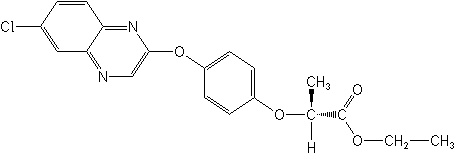Products >> Herbicides >> Quizalofop-p-ethyl
Quizalofop-p-ethyl
Quizalofop-p-ethyl 95%TC
Quizalofop-p-ethyl 12.5%EC
Quizalofop-p-ethyl 5%EC
Herbicide
HRAC A WSSA 1; aryloxyphenoxypropionate

NOMENCLATURE
quizalofop-P
Common name quizalofop-P (BSI, draft E-ISO)
IUPAC name (R)-2-[4-(6-chloroquinoxalin-2-yloxy)phenoxy]propionic
acid
Chemical Abstracts name (R)-2-[4-[(6-chloro-2-quinoxalinyl)oxy]phenoxy]propanoic
acid
CAS RN [94051-08-8]
Common name quizalofop-P-ethyl (BSI, draft E-ISO)
IUPAC name ethyl (R)-2-[4-(6-chloroquinoxalin-2-yloxy)phenoxy]propionate
CAS RN [100646-51-3] Development codes D(+) NC-302 (Nissan); DPX-79376
(Du Pont)
quizalofop-P-tefuryl
Common name quizalofop-P-tefuryl
IUPAC name (?-tetrahydrofurfuryl-(R)-2-[4-(6-chloroquinoxalin-2-yloxy)phenoxy]propionate
Chemical Abstracts name (RS)-2-tetrahydrofuranylmethyl (R)-2-[4-(6-chloro-2-quinoxalinyloxy)phenoxy]propanoate
CAS RN [119738-06-6] Development codes UBI C4874 (Uniroyal)
PHYSICAL CHEMISTRY
quizalofop-P
Mol. wt. 344.8 M.f. C17H13ClN2O4
quizalofop-P-ethyl
Manufacturers Nissan; IPESA
quizalofop-P-tefuryl
Manufacturers IPESA; Uniroyal
Quizalofop-p-ethyl APPLICATIONS
Biochemistry Acetyl CoA carboxylase inhibitor; inhibition of fatty
acid biosynthesis. Mode of action Systemic herbicide, absorbed from
the leaf surface, with translocation throughout the plant, moving
in both the xylem and phloem, and accumulating in the meristematic
tissue. Uses Selective post-emergence control of annual and perennial
grass weeds in potatoes, soya beans, sugar beet, peanuts, oilseed
rape, sunflowers, vegetables, cotton, and flax. Phytotoxicity Most
non-graminaceous crops are tolerant. Formulation types EC; SC. Compatibility
Can be used in combination with post-emergence broad-leaved herbicides.
Selected tradenames: 'CoPilot' (Nissan); 'Pilot D' (Nissan); 'Pilot
Super' (Nissan); 'Targa D+' (Nissan); 'Targa Super' (Nissan); 'Assure
II' (USA) (Du Pont); 'Herban LPU' (IPESA); 'Mostar' (IPESA); 'Omega'
(Argentina) (Du Pont); 'Sheriff' (Du Pont); 'Targa Prestige' (Aventis)
Mode of action Systemic herbicide, absorbed from the leaf surface,
with translocation throughout the plant, moving in both the xylem
and phloem, and accumulating in the meristematic tissue. Uses Control
of annual grasses such as Avena fatua and Alopecurus myosuroides,
and perennial grasses such as Sorghum halepense and Elymus repens,
in potatoes, flax, oilseed rape, peas, sugar beet, cotton, and soya
beans. Formulation types EC. Compatibility Certain post-emergence
broad-leaved herbicides are incompatible with quizalofop-P-tefuryl.
Selected tradenames: 'Pantera' (Uniroyal); 'Sector-T' (IPESA)
Quizalofop-p-ethyl OTHER TRADENAMES
'Leopard' (Makhteshim-Agan); 'Matador' (FMC); 'Sceptre' (Aventis)
quizalofop-P-tefuryl
Discontinued names: 'Logico' * (IPESA)
ANALYSIS
quizalofop-P-ethyl
Product by hplc. Residues by glc. Details from Nissan.
quizalofop-P-tefuryl
Details available from Uniroyal.
Quizalofop-p-ethyl MAMMALIAN TOXICOLOGY
Oral Acute oral LD50 for male rats 1210, female rats 1182, male
mice 1753, female mice 1805 mg/kg. NOEL (90 d) for rats 7.7 mg/kg
daily. Toxicity class EPA (formulation) II (5EC)
Oral Acute oral LD50 for rats 1012 mg/kg. Skin and eye Acute percutaneous
LD50 for rabbits >2000 mg/kg. Mild eye irritation; non-irritating
to skin (rabbits). Non-sensitising to skin (guinea pigs). Inhalation
LC50 (4 h) for rats >4.8 mg/l (12% EC). NOEL In chronic oncogenic
feeding studies, NOEL for rats 1.25, dogs 19 mg/kg b.w. daily. ADI
0.01 mg/kg. Toxicity class WHO (a.i.) II; EPA (formulation) III
ECOTOXICOLOGY
Birds Acute oral LD50 for mallard ducks and bobwhite quail >2000
mg/kg. Fish LC50 (96 h) for rainbow trout >0.5 mg/l. Daphnia
LC50 (48 h) 0.29 mg/l. Algae Assumed similar to racemate. Bees Assumed
similar to racemate. Worms LC50 >1000 mg/kg.
quizalofop-P-tefuryl
Birds Acute oral LD50 for bobwhite quail and mallard ducks >2150
mg/kg. LC50 (8 d) for bobwhite quail and mallard ducks >5000
ppm. Fish LC50 (96 h) for trout 0.51, sunfish 0.23 mg/l. Daphnia
LC50 (48 h) >1.5 mg/l. Algae LC50 (5 d) for Selenastrum >1.9
mg/l. Bees LD50 >100 mg/bee.
Quizalofop-p-ethyl ENVIRONMENTAL FATE
quizalofop-P-ethyl
Animals The degradation pattern is the same as that for quizalofop-ethyl.
Plants The degradation pattern is the same as that for quizalofop-ethyl.
Soil/Environment In soil, degrades rapidly to quizalofop-P; DT50
£1 d.